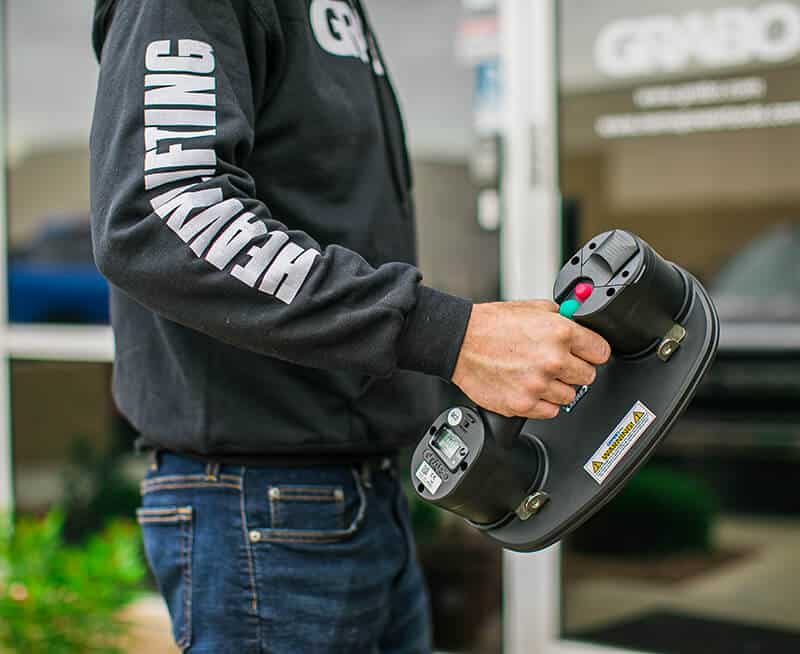GRABO – Jadikan DIY Mudah dengan Alat Suction Paver Ini.
Memindahkan dan mengangkat paver bisa menjadi suatu tantangan. Sisi baiknya, ini bukanlah pekerjaan yang harus sering Anda hadapi kecuali Anda berada di industri yang membutuhkannya. Di sisi lain jika Anda berencana untuk:
- Lansekap taman Anda,
- Pasang paver, atau
- Perbaiki paver yang cekung,
Maka kemungkinan besar Anda perlu mengangkat paver. Alat Hisap Paver GRABO dirancang untuk membantu Anda mengangkat paver dengan lancar, efisien, dan aman.
Jika Anda berurusan dengan paver secara teratur, Anda bisa mendapatkan keuntungan dengan memiliki Alat Hisap Paver GRABO.

Apa itu Alat Hisap Paver?
Alat Suction Paver GRABO mudah diangkat dan dibuat berat. Unit yang bagus dan ringan ini dirancang untuk mengangkat hingga 375lbs! Sifatnya yang serba guna menjadikannya alat yang berguna di banyak industri. Glazier menggunakannya untuk menggeser panel kaca besar tanpa meninggalkan bekas. Penggerak menggunakan dua GRABO secara bersamaan untuk memindahkan furnitur berukuran besar dari rumah ke rumah. Di lokasi konstruksi, GRABO Paver Suction Tool memiliki banyak kegunaan, mulai dari memindahkan potongan kayu besar hingga menahan drywall, ubin, batu bata, dan lainnya. Landscapers menganggapnya sebagai alat yang sangat berguna untuk memindahkan pavers.
Ini adalah alat yang diciptakan untuk mengangkat benda berat dengan aman melalui kekuatan hisap vakum.
Ini berarti ia menciptakan ruang vakum yang kuat antara dirinya dan objek yang Anda coba angkat, yang memastikan pegangan yang aman pada objek tersebut. Pengukur tekanan memberi tahu Anda bahwa pegangannya kuat, dan Anda dapat memindahkan barang itu menggunakan pegangan GRABO. Karena membutuhkan penahan vakum yang baik untuk bekerja, Alat Hisap Paver GRABO tidak akan menahan benda berpori, seperti batu dengan jutaan lubang kecil di dalamnya untuk mendorong drainase. Sifat keropos dari jenis batu ini akan mencegah terbentuknya segel vakum.

Bagaimana Alat Hisap Paver Dapat Membantu?
Setiap kali Anda harus memindahkan pavers ada daftar hal yang perlu dipertimbangkan:
- Pavers sering memiliki tepi tajam yang dapat memotong kulit.
- Beberapa paver sangat baik dalam mempertahankan suhu, jadi jika ada hawa dingin di udara, paver tersebut mungkin sangat dingin untuk dipegang. Jika ini adalah puncak musim panas, Anda harus berhati-hati agar tangan Anda tidak terbakar.
- Terlepas dari ukuran dan beratnya, paver seringkali cukup rapuh. Menyeimbangkannya dengan salah atau meletakkannya terlalu keras dapat menyebabkannya pecah atau pecah.
Tanpa masalah ini, seseorang juga harus mempertimbangkan bagaimana mereka berencana untuk mengangkat pavers terlebih dahulu. Jika mereka diletakkan mendatar satu sama lain atau rata di tanah, mereka akan sulit untuk diangkat. Inilah sebabnya mengapa Anda akan melihat mereka ditumpuk satu sama lain pada suatu sudut saat ditampilkan di toko, meskipun pendekatan ini dapat menyebabkan ujung-ujungnya pecah.
Alat Suction Paver GRABO dirancang untuk menahan berat hingga 375lbs!
Tips Mengangkat Paver Tanpa Alat Hisap Paver
- Saat mengangkat paver, Anda disarankan menggunakan sarung tangan kerja. Hal ini tidak hanya akan melindungi tangan Anda dari ujung yang tajam, tetapi juga memberikan cengkeraman ekstra pada paver itu sendiri.
- Simpan obeng pipih di dekat Anda. Saat paver rata dengan tanah, tepi yang rata dapat membantu Anda mengangkatnya dengan lembut ke atas sehingga jari Anda dapat berada di bawahnya.
- Minta bantuan teman. Orang tambahan dapat membantu Anda memasang paver di tempat yang tepat untuk pertama kalinya, mereka dapat membantu Anda mengangkat paver dengan aman dari tanah dan menyediakan sepasang tangan kedua jika paver terbukti terlalu berat untuk satu orang saja.
- Selalu periksa ruang kerja Anda untuk memastikan Anda berada di lingkungan yang aman.
Cara menggunakan Alat Hisap GRABO Paver
Alat Hisap GRABO Paver dapat membuat daftar di atas menjadi lebih sederhana. Sarung tangan masih direkomendasikan setiap kali Anda bekerja dengan paver, tetapi alat bertepi rata dan sepasang tangan ekstra tidak lagi menjadi persyaratan. Inilah cara Anda menggunakan alat hisap paver untuk memindahkan paver Anda ke tempat yang Anda butuhkan:
- Tekan dengan kuat GRABO ke paver yang ingin Anda angkat.
- Tekan tombol hijau. Ini mengaktifkan vakum dan memastikan GRABO memiliki pegangan yang aman di paver Anda.
- Angkat item dan pindahkan ke tempat yang Anda inginkan.
- Setelah paver Anda berbaris sempurna, letakkan dan tekan tombol merah untuk melepaskannya.
Anda dapat menggunakan metode serupa untuk paver yang tenggelam. Cukup angkat paver dari area cekungnya, perbaiki area tersebut agar aman dan rata sekali lagi, lalu ganti paver Anda. Tidak perlu repot, tidak perlu menghabiskan waktu berjam-jam untuk mencoba mengeluarkan paver, dan lebih sedikit peluang untuk memotong bagian tepinya.

Menjadi Orang Dalam GRABO
Dapatkan akses ke pembaruan prioritas dan bonus menarik lainnya sekarang.

